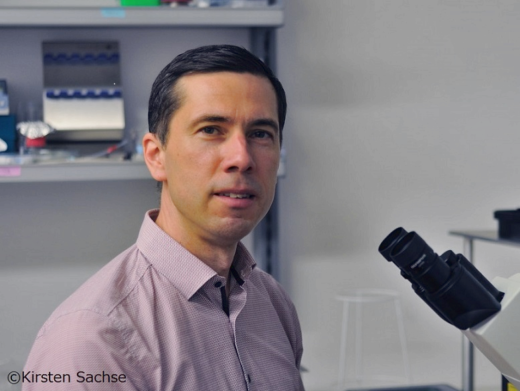Frontiers of cellular physics
Elucidating the mechanisms of the dynamic and collective behavior of cellular systems
 “I work at the interface of physics and biology in a field that is called cellular biophysics,” says Carsten Beta, an overseas PI at the WPI NanoLSI and professor at the Biological Physics Group at Potsdam University in Germany. “More specifically, I am studying cell motility, that is how cells move. Intuitively we know that cells move during their lifecycles—some crawl on surfaces others swim in liquids. This motion is essential for many biological functions. Well known examples include observations of wounds healing and immune system response. Less nicer examples are the spread of cancer cells and infections. They are all governed by cell motility.”
“I work at the interface of physics and biology in a field that is called cellular biophysics,” says Carsten Beta, an overseas PI at the WPI NanoLSI and professor at the Biological Physics Group at Potsdam University in Germany. “More specifically, I am studying cell motility, that is how cells move. Intuitively we know that cells move during their lifecycles—some crawl on surfaces others swim in liquids. This motion is essential for many biological functions. Well known examples include observations of wounds healing and immune system response. Less nicer examples are the spread of cancer cells and infections. They are all governed by cell motility.”
Beta’s group combine experiments with theoretical modelling to demystify the behavior and implications of cell motility. Experimental techniques include live cell imaging with laser-scanning confocal and total internal reflection fluorescence, computer-automated cell-tracking combined with optical tweezers for photo-activation, and PDMS-based microfluidics systems for the single cell experiments.
Theoretical research is focused on developing numerical models and data analysis, for example, Beta is collaborating with mathematicians to develop models to analyze experimental observations on cell motility.
Adaptive approaches for education and research in the COVID-19 era
“The last two years have created unique issues,” says Beta. “The shift to online teaching was challenging because we had not done it before, particularly the technical aspects such as preparing video lectures. The first semester was busy preparing lecture courses and we had no real time for research. On the research side, the degree of impact of COVID-19 depended on your location in Germany because COVID-19 regulations were set by local governments. Some universities had freedom to introduce their own measures to cope COVID.”
Beta adds that Potsdam University did not impose strict restrictions with staff and researchers being allowed access to labs and buildings albeit in much smaller numbers and reduced frequency.
“Initially the new rules seemed to be working well,” explains Beta. “But after a few months I realized that people were not able to talk with each other on a regular basis, which led to tensions. For example, you come to the lab and there may be equipment on a lab table, but you were not able to check what to do with it because it was difficult to contact the relevant people. So there was this form of stress.”
Beta introduced adaptive communications schemes to relieve tensions, such frequent online ‘coffee break meetings’ enabling people to talk with each other and exchange information to mitigate potential problems. “But it’s not a healthy situation to run research teams remotely,” confides Beta. “Many ideas come from conversations at the coffee machine. In spite of our regular online gatherings, some graduate students felt isolated and nervous about the progress of their projects.”
Positive by-products of the COVID-19 pandemic?
Beat says that some online teaching could be combined with conventional face to face lectures for more effective and richer experience of the learning process, examples being access to on-demand video courses for students unable to attend lectures. “But I would not like 100% online teaching.”
In terms of research, Beta has found online or hybrid conferences to be more convenient than conventional ones. For example, he was able to attend an APS meeting in the USA that he would not have been able to attend otherwise.
“Also I am able to meet with collaborators much more regularly than I did before COVID-19,” says Beat. “For example, I now frequently meet overseas colleagues online than I did before COVID-19 even though we already had the video conferencing technology. I think we have become used to remote online conversations now.”
Research at the NanoLSI in Kanazawa: Actin cytoskeletons and waves
Analysis of the dynamics of actin cytoskeletons is one of the main areas of research being pursued by Beta and his group. Actin cytoskeletons are biopolymer networks inside cells on the inner side of the plasma membrane that gives cells their mechanical properties and shapes. They are also the force responsible for generating shape changes that govern the crawling motion of cells and other functions such as cell division and phagocytosis–where cells ingest and eject large particles typically greater than half a micrometer.
“Actin cytoskeletons are very dynamic structures but they are not uniform and can transform into different kinds of structures usually by self-organization,” explains Beta. “Amongst these structures I am particularly interested in the dynamics of so-called actin waves that can travel through the cortical layer. They are precursors of structures that aid liquid uptake. They also impact motility and division processes.”
Beta is focused on elucidating how and why actin waves move the way they do to gain insights into cellular functions which in turn might enable the control the dynamics of actine waves.
“We know that actin waves can be influenced by the topology of the surroundings of cells,” says Beta. “But we do not know how cells sense topological features such a curvature of their surroundings. In particular, it is not known how this is related to their internal structural organization such as the filament networks inside actin waves. This is the aspect that brings in Kanazawa NanoLSI for me. Because researchers at the Institute have developed state of the art atomic force microscopy (AFM) technology to study these processes. I hope that by collaborating with NanaoLSI that it will be possible to obtain dynamic images of actin wave structures. Most of these techniques are not available to the wider research community, so the NanoLSI is the primary global institute at the forefront of this research.”
Thoughts about the WPI program
“The WPI program is a unique initiative,” says Beta. “At the Kanazawa NanoLSI it’s a strong interdisciplinary approach for advancing science by combining AFM technology with cancer research, and supramolecular chemistry, for example.”
Beta says he is looking forward to his next stay at the NanoLSI and looking around the sights of Kanazawa. “I am very fond of Japanese cuisine that is famous in Kanazawa. So I am looking forward to trying local food again. Also, I would like to visit the impressive Kenrokuen Gardens. So many great things to look forward to when I visit the NanoLSI again.”
Recent publications
- E. Moreno et al. From single to collective motion of social amoebae: a computational study of interacting cells. Front. Phys., 02 February 2022.
https://doi.org/10.3389/fphy.2021.750187
- G. Pasemann et al. Diffusivity estimation for activator–inhibitor models: Theory and application to intracellular dynamics of the actin cytoskeleton. Journal of Nonlinear Science, 31, (2021).
https://doi.org/10.1007/s00332-021-09714-4
- S. Flemming et al. How cortical waves drive fission of motile cells, PNAS, 6337, (2020).
https://doi.org/10.1073/pnas.1912428117
Further information
Prof. Carsten Beta’s episode on the NanoLSI Podcast.
Posted Mar. 15, 2023




